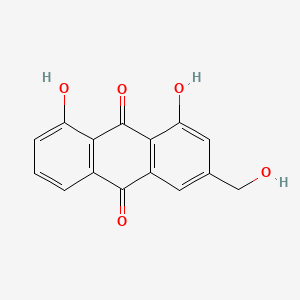Possible associated with:
| Structure | name | description | Reference count |
|---|---|---|---|

|
Aloe-emodin | Aloe-emodin is a lipid of Polyketides (PK) class. Aloe-emodin is associated with abnormalities such as Wiskott-Aldrich Syndrome. The involved functions are known as Anabolism, Phosphorylation, Signal Transduction, Cell Proliferation and Cell Survival. Aloe-emodin often locates in Body tissue, Cell Fraction, Mitochondria, Micronucleus and Microsomes, Liver. The associated genes with Aloe-emodin are MECHANISTIC TARGET OF RAPAMYCIN COMPLEX 2, RICTOR gene, PI3 gene, PRR5 gene and MANEA gene. | 451 |

|
emodin | emodin is a lipid of Polyketides (PK) class. Emodin is associated with abnormalities such as Infection, Conjunctivitis, Vernal, Stevens-Johnson Syndrome, Conjunctival scar and Allergic Conjunctivitis. The involved functions are known as signaling cascade, Metabolic Inhibition, Cell Death, Phosphorylation and JNK Pathway. Emodin often locates in Membrane, Protoplasm, Mitochondria, Cytoplasmic matrix and soluble. The associated genes with emodin are cytochrome c'', UTS2 gene, TK Gene, Gene Clusters and CFC1 gene. The related lipids are Phosphatidylserines, Promega, Sphingolipids, Membrane Lipids and Palmitates. The related experimental models are Mouse Model and Transgenic Model. | 1742 |

|
Thapsigargin | Thapsigargin is a lipid of Prenol Lipids (PR) class. Thapsigargin is associated with abnormalities such as Impaired glucose tolerance, Obesity and Blood Pressure Disorders. The involved functions are known as Phosphorylation, establishment and maintenance of localization, Regulation, Metabolic Inhibition and Proteolysis. Thapsigargin often locates in Mouse Skin, Cytoplasm, Skin, Protoplasm and Mitochondria. The associated genes with Thapsigargin are ERBB4 gene, F11 gene, CA1 gene, TRNAP1 gene and HSPA5 gene. The related lipids are taurolithocholic acid 3-sulfate, Liposomes, Fatty Acids and stearylamine. The related experimental models are Mouse Model. | 8868 |

|
forskolin | Forskolin is a lipid of Prenol Lipids (PR) class. Forskolin is associated with abnormalities such as Cholestasis, Vocal cord dysfunction familial, Hypothyroidism, Renal tubular disorder and Disintegration (morphologic abnormality). The involved functions are known as Cell Proliferation, Anabolism, mRNA Expression, Agent and Signal. Forskolin often locates in Extracellular, Body tissue, Skin, Tissue membrane and Membrane. The associated genes with forskolin are P4HTM gene, SLC33A1 gene, NR1I2 gene, Genes, Reporter and CYP3A gene. The related lipids are Steroids, steroid sulfate, Fatty Acids, LYSO-PC and Lipopolysaccharides. | 24755 |
Total
4